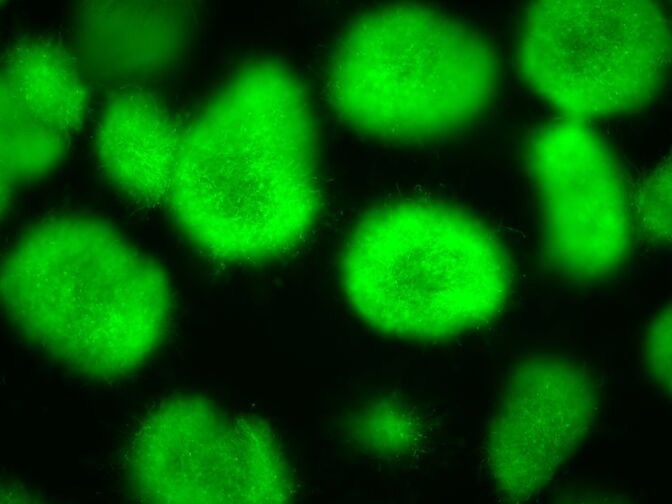Reviewed by Danielle Ellis, B.Sc.Jun 28 2023
Chemical substances called arginoketides, which are produced by bacteria of the genus Streptomyces, cause a variety of reactions in other microorganisms: Algae group together to form aggregates, fungi produce signaling molecules that they would not otherwise produce, and bacteria develop biofilms that cause other organisms to respond differently.
 This Aspergillus nidulans reporter strain produces green fluorescent protein (GFP) when a specific gene cluster is activated. This in turn happens when an arginoketide is added. Image Credit: Maira Rosin/Leibniz-HKI
This Aspergillus nidulans reporter strain produces green fluorescent protein (GFP) when a specific gene cluster is activated. This in turn happens when an arginoketide is added. Image Credit: Maira Rosin/Leibniz-HKI
This was demonstrated in a study by scientists at the Leibniz Institute for Natural Product Research and Infection Biology (Leibniz-HKI), which looked at various Streptomyces species, the arginoketides they create, and their effects on other soil microorganisms.
Microorganisms can interact with one another despite the fact that they cannot speak. They accomplish this by using chemicals that serve as signals for other microorganisms.
These are relatively small organic compounds, known as natural products. Microorganisms produce a variety of such compounds and we are just beginning to understand this language.”
Axel Brakhage, Study Head and Director, Leibniz Institute for Natural Product Research and Infection Biology
Bacteria of the genus Streptomyces are apparently particularly important for communication in the soil. They are found all over the world and produce many different arginoketides, as was recently discovered by researchers at the Leibniz-HKI in a study published in Nature Microbiology.
Arginoketides are a subgroup of polyketides, a group of natural products produced by various organisms. Many polyketides are of medical interest because they, for example, are antibiotics or act against cancer cells.
Polyketides, a class of organic compounds made by diverse organisms, include arginoketides as a subgroup. The fact that many polyketides are antibiotics or have anticancer effects makes them of interest to the medical community.
The group of arginoketides discovered by the Leibniz-HKI team activates a variety of activities in the soil.
In previous studies, we have already seen that the fungus Aspergillus nidulans produces some substances only in the presence of streptomycetes.”
Maria Stroe, Study Lead Author and Research Assistant, Leibniz Institute for Natural Product Research and Infection Biology
The current study intended to determine whether streptomycetes produce additional compounds that function as signaling agents.
Through a literature search, we found a large number of examples where Streptomyces species worldwide produce structurally similar compounds or at least have biosynthetic gene clusters for corresponding arginoketides.”
Mario Krespach, Study Lead Author, Leibniz Institute for Natural Product Research and Infection Biology
Some of these compounds were identified from Streptomyces strains isolated from soil samples and successfully tested on mold Aspergillus nidulans—they also induced the creation of chemical substances in the fungus that it does not normally produce.
Lukas Zehner, another author of the study, added, “We therefore suspected that we may have found a general mechanism of microbial communication.”
Indeed, the researchers discovered a huge number of fungi in soil samples that generated substances that normally do not form in the absence of Streptomyces iranensis. The result was not observed when the researchers turned off the associated arginoketide production genes.
Previous research found that arginoketides induce a fungus and a green alga to develop a symbiosis, another fungus to change shape, and a bacterium to form a biofilm in reaction to the substances.
Brakhage added, “We are now trying to understand the effects on the composition of microbial communities, the microbiomes, both from arginoketide production itself, and also from the substances produced from fungi in response.”
For instance, one of the substances made by Aspergillus nidulans suppresses a fungus that causes plant disease. Lichens and multicellularity could have evolved as a result of arginoketide impacts on fungi and algae.
Brakhage concluded, “Elucidating this interplay helps us understand, among other things, how microbial communities are structured and how they help prevent plant diseases. In addition, we discover entirely new substances when we study the coexistence of microorganisms instead of just looking at isolated organisms.”
Source:
Journal reference:
Krespach, M. K. C., et al. (2023). Streptomyces polyketides mediate bacteria–fungi interactions across soil environments. Nature Microbiology. doi.org/10.1038/s41564-023-01382-2